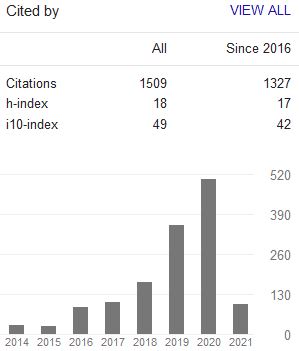VISHNU IN TWO CLASSICAL JAVANESE ISLAMIC TEXTS: Continuity and Harmony among the Javanese Revisited
Abstract
Keywords
Full Text:
PDFReferences
Arniati, Ida Ayu. “Dewa Laksmi sebagai Simbol Kesuburan dalam Prespektif Gender”. Widya Wretta 13, 1 (2007).
Baried, Baroroh. Pengantar Teori Filologi. Yogyakarta: Badan Penelitian dan Publikasi Fakultas Sastra Universitas Gadjah Mada, 1994.
Beatty, A. Varieties of Javanese Religion: An Anthropological Account. Cambridge: Cambridge University Press, 1999
Booger, Jochem van den. “The Role of Slametan in the Discourse on Javanese Islam”. Indonesia and the Malay World 45, 133.
Cederroth, S. From Syncretism to Orthodoxy?: The Struggle of Islamic Leaders in an East Javanese Village. Copenhagen: Nordic Institute of Asian Studies, 1991
Chambert-Loir, Henry. Cerita Asal Bangsa Jin dan segala Dewa-dewa. Bandung: Angkasa, 1985.
Chawcharia, Ajai Kumar. The 24 Avtars (incarnations) of Lord Vishnu. Ayodhdhya: Faizabad, U.P. India, 2014.
Daniels, T.P. Islamic Spectrum in Java. Farnham: Ashgate, 2009
De Graaf, H.J. and Th. G. Pigeaud. Kerajaan-kerajaan Islam di Jawa: Peralihan dari Majapahit ke Mataram. Jakarta: Grafiti press, 1986.
Geertz, C. The Religion of Java. New York: Free Press, 1964.
Hall, D.G.E. History of Southeast Asia, London, New York: Mac Milan & Co Ltd., 1955.
Hefner, R.W. “Where have all the Abangan gone? Regionalization and the decline of non-standard Islam in contemporary Indonesia. In M. Picard,” and R. Madinier (eds), The politics of religion in Indonesia: syncretism, orthodoxy, and religious contention in Java and Bali. Abingdon: Routledge, 2011.p. 71–91.
Hefner, R.W. Hindu Javanese: Tengger Tradition and Islam. Princeton NJ: Princeton University Press. First published 1989.
Hilmy, M. “Islam and Javanese Acculturation: Textual and Contextual Analysis of the Slametan Ritual”. MA thesis, McGill University, Canada, 1999.
Hudson, Dennis. The Body of God: an Emperor's Palace for Krishna in Eighth-Century. Oxford: Oxford University Press USA, 2008.
Ilyas, Deddy, “Antara Surga dan Neraka”. Jurnal ilmu Agama 14 (2016), pp. 113-128.
Kamajaya, Karkana Parta Kusuma. Kebudayaan Jawa, Perpaduannya dengan Islam. Yogyakarta: IKAPI, 1995.
Kavakebi, Cima. ”Trimurti Manifestation in Hindu Temples”. JACO Quarterly 10 (2016).
Keeler, W. Javanese Shadow Plays, Javanese Selves. Princeton NJ: Princeton University Press. 1987.
Koentjaraningrat. Kebudayaan Jawa, Jakarta: Balai Pustaka, 1994.
Leopold, A.M. (ed.) Syncretism in Religion: A Reader. London: Equinox, 2004.
Liebert, Gosta. “Iconography dictionary of the Indian Relegions. Hinduism-Buddhism-Jainism”. Studies in South Asian Culture V (Leiden: E. J. Brill. 1976).
Maharsi. “Simbolisme dalam Arsitektur Masjid Demak”. Jurnal Thaqafiyyah 5 (2008).
Makin, Al. “Unearthing Nusantara’s Concept of Religious Pluralism:
Harmonization and Syncretism in Hindu-Buddhist and Islamic
Classical Texts”. Al-Jami'ah: Journal of Islamic Studies 54, 1 (2016).
Mulder, N. Inside Indonesian Society: Cultural Change in Java. Yogyakarta: Kanisius. 3rd edition, 2005.
Poensen, C. “Bijdragen tot de kennis van den godsdienstigen en zedelijken toestand des Javaans.” Mededeelingen van wege het Nederlandsche Zendelinggenootschap 9 (1865).
----------. “Een en ander over den godsdienstigen toestand van den Javaan”. Mededeelingen van wege het Nederlandsche Zendelinggenootschap 8 (1864).
----------. Brieven over den Islām uit de Binnenlanden van Java [Letters about Islam, from the interior of Java. Leiden: E.J. Brill, 1866.
Randyo, M. “Kresna Gugat dalam Pertunjukan Wayang Kulit Piurwa, Gelar Jurnal Seni dan Budaya 11, 1 (2013).
Ricklefs, M.C. Islamisation and its opponents in Java: a political, social, cultural and religious history, c. 1930 to the Present. Singapore: NUS Press. 2012
----------. Mystic synthesis in Java: a history of Islamization from the fourteenth to the early nineteenth centuries. Norwalk CT.: EastBridge. 2006.
Rubaidi, “Javanese Islam; A Blend of Javanese and Islamic Mysticism Viewed from Post-Colonial Perspective.” El Harakah 21, 1 (2019).
Sang, Jingyu and Wimal Hewamanage, “Mythology of Gods: Origin and Development of the Concept of Gods in Indian Religion.” Sri Langka International Journal of Buddhist Studies (SIJBS) 4 (2015).
Siti Maziyah. “Sumbangan Cerita Samuderamathana Terhadap Pemahaman Arti Air Penghidupan Pada Masyarakat Jawa Kuno”. Jurnal Citra Lekha 4, 1 (2001).
Soekmono. “Candi, Fungsi, dan Pengertiannya”. Unpublished PhD Dissertation, Universitas Gadjah Mada, Yogyakarta (1974)
Sudaryati. Ni Luh Gede. “Pemanfaatan dan Makna Air dalam Veda.” Vidya Wertta 1, 2 (2018), p. 107-116.
Susilo, Sulistyono. “Common identity Frame work of Cultural Knowledge and practices of Javanese Islam”. Indonesian Journal of Islam and Muslim Sicieties 6, 2 (2016).
Vidyalankar, Amamath. The Holy Vedas. Punjab: Clarion Books, 1983.
Woodward, M.R. Islam in Java: Normative Piety and Mysticism in the Sultanate of Yogyakarta. Tucson AZ: University of Arizona Press, 1989.
----------. Java, Indonesia and Islam. Dordrecht: Springer, 2011.
Zoetmulder, P.J. The Cultural Background of Indonesian Politics. Colombia: Institute of International Studies, University of South Carolina, 1967.
DOI: 10.15642/JIIS.2023.17.1.124-146
Refbacks
- There are currently no refbacks.
Indexed by:
Journal of Indonesian Islam (ISSN 1978-6301 and E-ISSN 2355-6994) is published by the Postgraduate Program (PPs) and the Institute for the Study of Religion and Society (LSAS), State Islamic University (UIN) of Sunan Ampel Surabaya.
Journal of Indonesian Islam by http://jiis.uinsby.ac.id/index.php/JIIs/index is licensed under a Creative Commons Attribution-ShareAlike 4.0 International License.
Copyright ©2020 State Islamic University (UIN) of Sunan Ampel Surabaya. Powered by Public Knowledge Project OJS.







